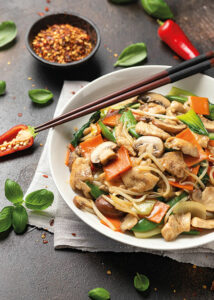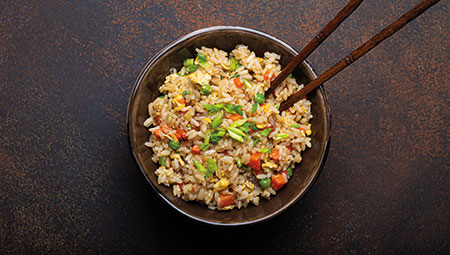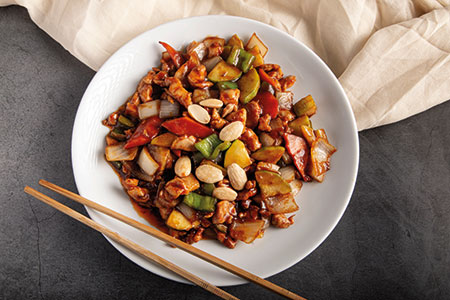

Chinese cuisine is one of the three most popular cuisines around the globe, together with French and Italian cuisine.
It certainly made its mark on international food culture, but at the same time was the object of many a crime of lèse-majesté́, with counterfeits, imitations and outright inventions that amount to nothing less than treason. Some naive, others funny, but all driven by the need to, literally, cater to local tastes.

Chinese cuisine is known for its diversity, complexity, and distinctive regional styles. From the fiery spices of Sichuan to the delicate dim sum of Cantonese cuisine, China’s culinary heritage is vast and multifaceted.
Over centuries, Chinese immigrants have spread the love for their food to every corner of the world. Today, you can find a Chinese restaurant in almost every city and town on the planet.
The tale of Chop Suey
One of the most amusing and baffling chapters in the globalisation of Chinese cuisine is the tale of “chop suey.” In the late 19th century, Chinese immigrants in the United States sought to create a dish that would satisfy American palates. The result was “chop suey,” a mishmash of meat, vegetables, and a starchy, syrupy sauce. This culinary fabrication quickly became a sensation, leading to its viral spreading in American Chinese restaurants.
However, the term “chop suey” itself is believed to be a mispronunciation of the Cantonese words “tsaap sui,” which loosely translates to “bits and pieces.” This humorous linguistic twist illustrates how a dish can be created, loved, and celebrated under a name that has little to do with its origins.
Cantonese Rice was made up for European diners.

Similarly, Cantonese Rice was another fabrication, born in the period when Asian cuisine started to become popular in Europe, in the 50’s and 60’s. It took after the reputation Cantonese cuisine had with European adventurous diners, yet there is no such thing as “Cantonese Rice” in Canton, let alone in the rest of China. Chinese restaurateurs in Europe just made up the name for this vague relative of pan-Chinese “fried rice”, which is indeed authentic and dates to the 6th Century.
The Western version is generally made with peas, ham and strips of omelet and served as a side, doused with soy sauce.
The luck of Fortune Cookies
Fortune cookies, the crispy, sweet snacks with well-wishing messages hidden inside,
are common in many Chinese restaurants outside China. Surprisingly, they aren’t Chinese. Japanese immigrants in early 20th century California created them. They were first served in Japanese tea gardens and later in Chinese restaurants. The idea was then exported to Europe, always eager to adopt the latest American fads, and today fortune cookies are a common staple found in most Chinese restaurants in the old continent too.
Chicken with almonds, anyone?
Another typical example of westernized Chinese cuisine, chicken with almonds
was first introduced in ethnic Chinese restaurants abroad simply because those early restaurateurs were not professional cooks back in China. Chicken with almond is considered an easy dish for amateur home cooks, and certainly not part of traditional cuisine. You wouldn’t think of ordering it at a restaurant, nor would a restaurant think of putting it on the menu, yet it is one of the most popular dishes in Chinese eateries around the world.

Sweet and Sour debacle
That’s got to be truly Chinese, right? Not really, and certainly not in the version normally served in your average Chinese restaurant outside China. Not that Sweet and Sour as a concept doesn’t exist in Chinese gastronomic tradition, but it is a lot subtler and much more nuanced. Balance of flavours is key to the true Chinese way, with a hint of tanginess complementing the sweetness. Westernised Chinese restaurants offer a simplified and rogue version of the concept, often expressed through heavy and syrupy sauces that are much sweeter and tangier than their traditional counterparts. Sweet and Sour pork, a common item on menus outside China, is a typical example of a dish that was created to satisfy foreign customers in their quest for an exotic “sweet and sour” experience. The pineapple wedges often found in it equate to the pineapple on the pizza that infuriate Italians.
Chinese cuisine’s journey around the world has been marked by both genuine appreciation and clumsy misunderstandings. While misinterpretations and humorous anecdotes may abound, the true essence of Chinese cuisine lies in its ability to bridge cultural gaps and bring people together over a shared love for a delicious food that is part of a millenary tradition. For one, we should stop thinking of Chinese cuisine as if it was a single entity and start appreciating the fact that there is indeed a myriad of different cuisines in China, each with its own characteristics, ingredients and flavours, with each and everyone of them worth discovering for what it truly is.
Typical Ingredients of Chinese Cuisine and Their Refrigeration Guidelines
Below are 10 typical ingredients of Chinese cuisine along with how they should be stored in the refrigerator.
To preserve your food in the best possible way, consider using large refrigerators such as four-door refrigerators that offer more options. With Homa MULTICLIMATE SYSTEM™: you achieve superior food preservation, ensuring your ingredients stay fresh and safe for longer periods.
1. Tofu
◦ Storage: Keep in its original packaging or transfer to an airtight container.
◦ Refrigeration: Yes
◦ Shelf Life: Consume within 3-5 days of opening.
2. Bok Choy
◦ Storage: Store in a plastic bag or container with a slightly damp paper towel to retain moisture.
◦ Refrigeration: Yes
◦ Shelf Life: Best used within 3-5 days.
3. Ginger
◦ Storage: Wrap in paper towels and place in a plastic bag or airtight container.
◦ Refrigeration: Yes
◦ Shelf Life: Can last up to 3 weeks.
4. Garlic
◦ Storage: Keep whole heads in a cool, dry place. Peeled cloves should be stored in an airtight container.
◦ Refrigeration: Whole heads: No, Peeled cloves: Yes
◦ Shelf Life: Whole heads can last up to several months, while peeled cloves should be used within a week.
5. Spring Onions (Green Onions)
◦ Storage: Store in a plastic bag or container with a damp paper towel.
◦ Refrigeration: Yes
◦ Shelf Life: Best used within 1-2 weeks.
6. Chinese Eggplant
◦ Storage: Keep in a plastic bag in the vegetable crisper drawer.
◦ Refrigeration: Yes
◦ Shelf Life: Use within 5-7 days.
7. Snow Peas
◦ Storage: Store in a plastic bag in the vegetable crisper drawer.
◦ Refrigeration: Yes
◦ Shelf Life: Best used within 3-5 days.
8. Bamboo Shoots
◦ Storage: Fresh shoots should be peeled and stored in water, changed daily. Canned shoots should be transferred to an airtight container after opening.
◦ Refrigeration: Yes
◦ Shelf Life: Fresh shoots should be used within a week, while canned shoots can last up to a week once opened.
9. Chinese Sausage (Lap Cheong)
◦ Storage: Keep in its original packaging or transfer to an airtight container.
◦ Refrigeration: Yes
◦ Shelf Life: Can last up to several months when vacuum-sealed and refrigerated.
10. Fermented Black Beans
◦ Storage: Store in an airtight container.
◦ Refrigeration: Yes
◦ Shelf Life: Can last up to a year.
Homa Design Magazine is a vibrant editorial venture on a mission to ignite the flame of design thinking across the entire Homa community—encompassing Homa people, our partners, and beyond! Yet, its influence extends beyond these boundaries; it serves as a beacon of design culture poised to illuminate our entire industry.
Today, it stands as a remarkable testament to the potency of tangential marketing, presenting a novel approach to captivating audiences. The magazine is the result of a collaborative effort, with the original idea stemming from Homa Europe.
Editor in Chief: Federico Rebaudo
Project Coordination: Federico Gallina
Contributing writers: Elena Scandroglio, Pierre Ley, Patrizio Cionfoli
Coordination, Design & Layout: Studio Volpi
For further information and Press Contact: info@homaeurope.eu
Copyright HOMA 2024- Issued By Homa Marketing dept. on July 2024
